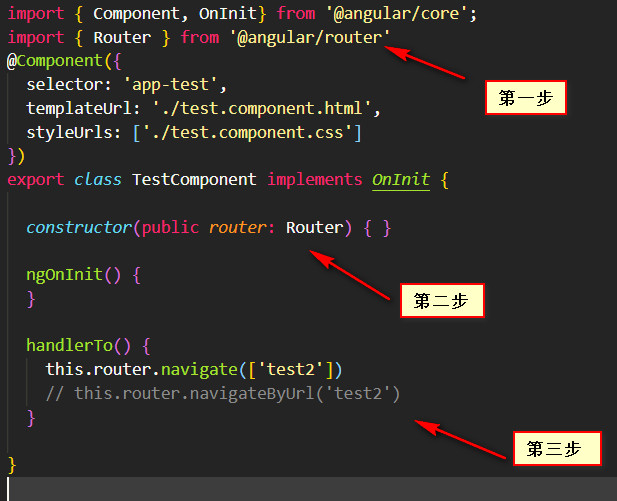一、定义路由
方法一:直接在app.module.ts中配置

1 import { BrowserModule } from '@angular/platform-browser'; 2 import { NgModule } from '@angular/core'; 3 import { AppComponent } from './app.component'; 4 import { TestComponent } from './test/test.component'; 5 import { Test1Component } from './test1/test1.component'; 6 import { Test2Component } from './test2/test2.component'; 7 import {Routes, RouterModule} from '@angular/router' 8 9 const appRoutes: Routes = [ 10 {path:'',component:TestComponent}, //代表默认路径,当URL为空时匹配的组件 11 {path:'test1',component: Test1Component}, 12 {path:'test2',component: Test2Component}, 13 {path:'**',component:TestComponent} //代表匹配其他未定义路径显示的组件,可以在这里展示404页面 14 ] 15 16 @NgModule({ //功能合集 17 declarations: [ //可以放组件,指令,管道 18 AppComponent, 19 TestComponent, 20 Test1Component, 21 Test2Component 22 ], 23 imports: [ 24 RouterModule.forRoot(appRoutes), 25 BrowserModule, 26 ], 27 providers: [], //服务,放公用的业务逻辑 28 bootstrap: [AppComponent] //从那个组件开始启动 29 }) 30 export class AppModule { }
方法二:路由模块
首先使用 ng g module app-routing --flat --module=app 创建 app-routing.module.ts文件

1 import { BrowserModule } from '@angular/platform-browser'; 2 import { NgModule } from '@angular/core'; 3 import { AppComponent } from './app.component'; 4 import { TestComponent } from './test/test.component'; 5 import { Test1Component } from './test1/test1.component'; 6 import { Test2Component } from './test2/test2.component'; 7 import { RouterModule} from '@angular/router'; 8 import { AppRoutingModule } from './app-routing.module' 9 10 11 @NgModule({ //功能合集 12 declarations: [ //可以放组件,指令,管道 13 AppComponent, 14 TestComponent, 15 Test1Component, 16 Test2Component, 17 ], 18 imports: [ 19 RouterModule, 20 BrowserModule, 21 ], 22 providers: [], //服务,放公用的业务逻辑 23 bootstrap: [AppComponent] //从那个组件开始启动 24 }) 25 export class AppModule { }

1 import { NgModule } from '@angular/core'; 2 import { CommonModule } from '@angular/common'; 3 import { Routes, RouterModule } from '@angular/router' 4 import { TestComponent } from "./test/test.component"; 5 import { Test1Component } from "./test1/test1.component"; 6 import { Test2Component } from "./test2/test2.component"; 7 8 const routes: Routes = [ 9 {path:'',component:TestComponent}, 10 {path:'test1',component: Test1Component}, 11 {path:'test2',component: Test2Component}, 12 {path:'**',component:TestComponent} 13 ] 14 15 @NgModule({ 16 imports: [ 17 CommonModule, 18 RouterModule.forRoot(routes) 19 ], 20 declarations: [] 21 }) 22 export class AppRoutingModule { }
注意:两种方法只能使用其一
二、路由出口
<router-outlet></router-outlet>
注意:需要在app.module.ts中写 import { RouterModule} from '@angular/router';
三、路由常用配置项
1. path 路径
2. component 组件
3. redirectTo 路由重定向
4. pathMatch 是一个用来指定路由匹配策略的字符串。可选项有 prefix(默认值) 和 full
【prefix:以指定的路径开头;full:与指定路径完全一样。】
四、路由跳转
1. a标签跳转
在html标签内使用routerLink跳转

2. 编程式导航
首先在test.component.html页面中添加点击事件

然后在test.component.ts中

五、路由传参
例子是由test页面跳转到test1
方法一:动态路由传参
第一步:在路由配置中将test1的路由配置为如下:

第二步:在test页面的HTML中跳转的地方写成如下格式:

第三步:在test1的ts文件下如下接收传过来的参数:

import { Component, OnInit } from '@angular/core';
import {ActivatedRoute} from "@angular/router" //要先进行引入
@Component({
selector: 'app-test1',
templateUrl: './test1.component.html',
styleUrls: ['./test1.component.css']
})
export class Test1Component implements OnInit {
constructor(private routeInfo:ActivatedRoute) { } //先定义routeInfo,可以是任意名字
ngOnInit() {
console.log(this.routeInfo.snapshot.params)
}
}
方法二:查询方式传参
第一步:在test页面跳转的地方:

第二步:在test1中接收

方法三:query传参
第一步: 在test页面添加跳转的点击事件

第二步: 在test.component.ts中对将要传入的数据进行定义

第三步: 在test1.component.ts中接收传递的参数

